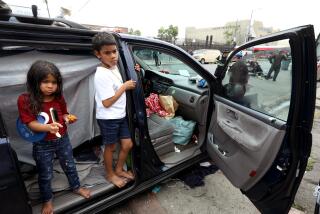PICO-UNION : Center Is Salvation for Youths, Families
- Share via
Many youngsters in Pico-Union have grown up with the Salvation Army’s Red Shield Youth and Community Center. Perhaps a few have grown up because of it.
“If the center weren’t here they’d be in the streets,” Executive Director Irene DeAnda Lewis said as she talked about the children who play and learn Monday through Saturday in the facility at 1532 W. 11th St.
Trouble in the form of gangs, drugs and crime lurks in the neighborhood. But the center offers a haven for youngsters and their families in an area starved for parks, gyms, pools and recreation space.
“This is really the only safe recreation facility in all of Pico-Union,” said Allyn Shapiro, principal of the 10th Street Elementary School across the street from the center.
Established in 1950, the center has dealt with its share of roughnecks and bullies over the years. Robert Aguirre, the center’s assistant program director, recalled that when he started going to the center as a child in 1969, gangs on the street made people think twice about going inside. “There were always guys hanging around wanting to start something,” Aguirre, 29, said. “I’m glad I had the support of my family. Some of my old friends are gone, in jail or in gangs.”
But through the efforts of the Police Department’s Rampart Division and the vigilance of the staff and the 10th Street teachers, the gangs have been pushed away from the center and the members, now as many as 3,900, can come without fear, Aguirre said.
What they find is a range of activities: basketball, swimming, arts and crafts, cooking classes, billiards, karate and English as a Second Language classes.
The center’s staff also offers children help with their homework and extracurricular tutoring.
“We found that some of the children were falling behind and needed extra support,” Lewis said. The center also has a small library and several donated computers with math and spelling programs and other educational games.
Arturo Magana, a 10th Street first-grader, is a regular at the center and an unofficial computer consultant. On a recent afternoon he signed on to one of the computers, shook his fist at it when it rejected his first command, then wiped his brow in relief when he got into his spelling program.
An older boy seated next to Arturo stared at his own screen. “Hey, what do I do now?” he asked Arturo, who hopped up from his chair, tapped out the proper command on the other boy’s keyboard and then returned to his own.
How did Arturo get so good at this?
“I just learned,” he said. “I come here every day. I like it better than school.” He sticks with the educational games, though he cast an occasional longing glance at two older boys playing an Atari road-racing game.
“I’m too young,” Arturo said. “I’d crash.”
More than 30,000 youths up to age 19 live within a 15-block area around the center, according to the 1990 U.S. census. Five schools--10th Street, Leo Politi, Magnolia, Hoover and Berendo--with a total of 9,700 students--send children to the center for after-school activities, Shapiro said.
The median family income in the area hovers around $15,000 a year, so annual memberships are low--$5 for children 12 and younger, $15 for teen-agers and $20 for adults.
Teachers at 10th Street contribute to a scholarship fund, which is matched by donations from Arco, to pay fees for 30 to 40 children who couldn’t otherwise afford it, Shapiro said.
It’s an investment in the future, in more ways than one.
“We have many people coming now as adults (to use the center) who started coming as children,” Lewis said.
Information: (213) 381-3747.
More to Read
Sign up for Essential California
The most important California stories and recommendations in your inbox every morning.
You may occasionally receive promotional content from the Los Angeles Times.













